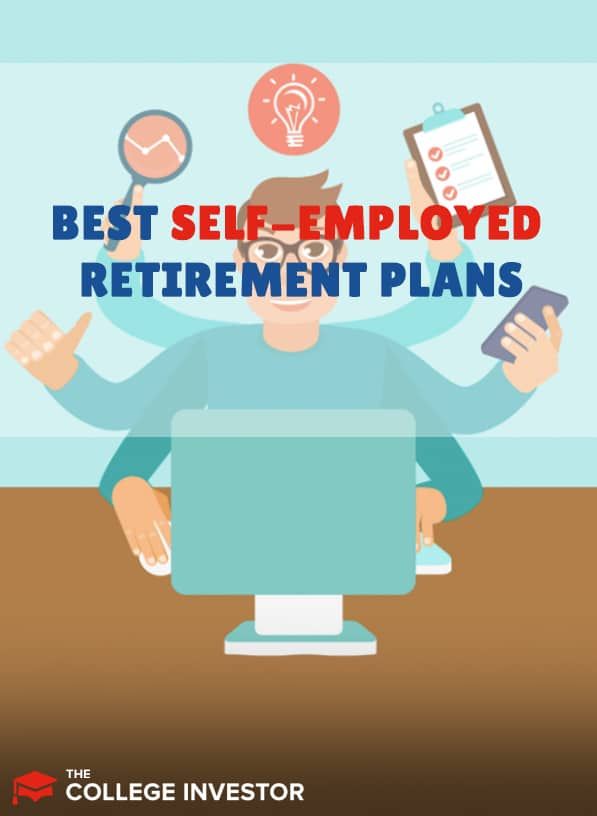
Shifting from working for an employer to self-employment can be tough financially, because the burden of setting up a lot of the “financial tools” for your future shift to you. When you work a job, your employer takes care of your insurance (or at least offers you options), and your retirement is typically through company-sponsored 401(k)s or maybe even a pension.
Now, once you become self-employed, you have to do it yourself. Setting up these accounts was one of the biggest issues I hear from readers all the time.
The nice thing is, there are a lot of options when it comes to self-employed retirement plans. No matter your situation, there is probably an option that will work well for you.
The main self-employed retirement plans are:
- SEP-IRA
- Solo 401(k)
- SIMPLE IRA
SEP-IRA
The SEP-IRA is the go-to retirement savings account for one-man businesses. If you’re a self-employed entrepreneur, this can be a good choice for you.
You can contribute up to as much as 25% of your net income, up to a maximum of $66,000 (in 2023). See the SEP IRA Contribution Limits here.
The great thing about this is that, like any other IRA, you have until April 15 to fund your account. That means you can file your taxes and make a larger contribution to trim your tax bill.
Another huge plus is that contributing to a SEP-IRA won’t interfere with your contributions to a 401(k) plan. That means if you’re starting your business on the side while working full-time, you can still take advantage of your employer’s plan while building your own business.
The only drawback to the SEP-IRA is if you ever hire employees. The IRS views the money you put into the SEP-IRA as an employer contribution, so if you hire workers, you have to contribute the same amount to their SEP-IRAs too. However, for the solopreneur, this doesn’t really matter.
Solo 401(k)
The Solo 401(k) can be a good choice for business owners who have significant earnings they want to save.
With a Solo 401(k), as an employee, you can save $22,500. Then, as the employer, you can contribute another 25% of compensation, up to a maximum of $66,000. Then there’s the catch-up contribution if you’re 50 or older, which is another $7,500. That means you can save a total of $66,000 or $73,500 in a Solo 401(k) per year.
Check out the full 401k Contribution Limits here.
Because of the high contribution limits, this plan is best for entrepreneurs who make a lot and are able to save it.
There will typically be fees associated with setup and annual maintenance, but they’ll be low for a small business or self-employed business.
Also, just like a regular 401(k), you can always borrow from your Solo 401(k), although it’s not recommended.
The biggest drawbacks of the Solo 401(k) are that only the self-employed business owner and a spouse can participate, and if you have a 401(k) at your nine-to-five job, you may already be contributing the max. The IRS limits apply to all 401(k) contributions, so if you’re depositing $22,500 at work, you can’t deposit any more being self-employed.
Check out our list of the best solo 401k providers. Or check out RocketDollar if you're looking for a Self-Directed Solo 401k.
SIMPLE IRA
Finally, the third option is the SIMPLE IRA. This is also known as the Savings Incentive Match Plan for Employees.
This is the ideal plan for businesses that have employees and want to offer them a plan as a perk (that you can also possibly take advantage of). This is designed for small businesses, with a mandatory limit of less than 100, but ideally less than 10.
You can make contributions of up to $15,500 pretax, or $19,000 if you’re 50 or older. There aren’t any income restrictions, and your contributions are tax-deductible.
Inside the account, your investments grow tax-deferred, just like any other IRA.
As the employer, you’re generally required to match the employee contribution up to 3% of the employee’s salary, dollar for dollar. This can make it burdensome for small firms.
You should also note that this plan isn’t for side jobs. You can’t contribute to the plan if you’ve already maxed out employee contributions to a 401(k) at your day job.
Remember, when it comes to these types of accounts, you should consult both a tax advisor or accountant and a financial planner. These accounts come with serious tax implications if not set up correctly (and huge benefits if set up correctly), and they may also require different types of paperwork.
You can open any of these accounts at a discount brokerage, including my favorite discount brokerages. Plus, Charles Schwab and others will offer you assistance in setting up your accounts for free.
Which do you think is the best self-employed retirement plan? Do you have experience with any of these?

Robert Farrington is America’s Millennial Money Expert® and America’s Student Loan Debt Expert™, and the founder of The College Investor, a personal finance site dedicated to helping millennials escape student loan debt to start investing and building wealth for the future. You can learn more about him on the About Page or on his personal site RobertFarrington.com.
He regularly writes about investing, student loan debt, and general personal finance topics geared toward anyone wanting to earn more, get out of debt, and start building wealth for the future.
He has been quoted in major publications, including the New York Times, Wall Street Journal, Washington Post, ABC, NBC, Today, and more. He is also a regular contributor to Forbes.
Editor: Clint Proctor Reviewed by: Chris Muller
